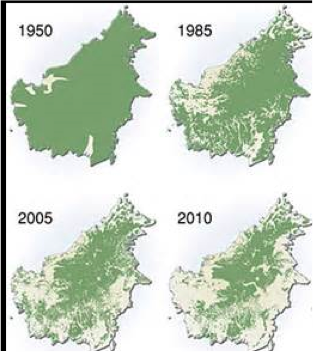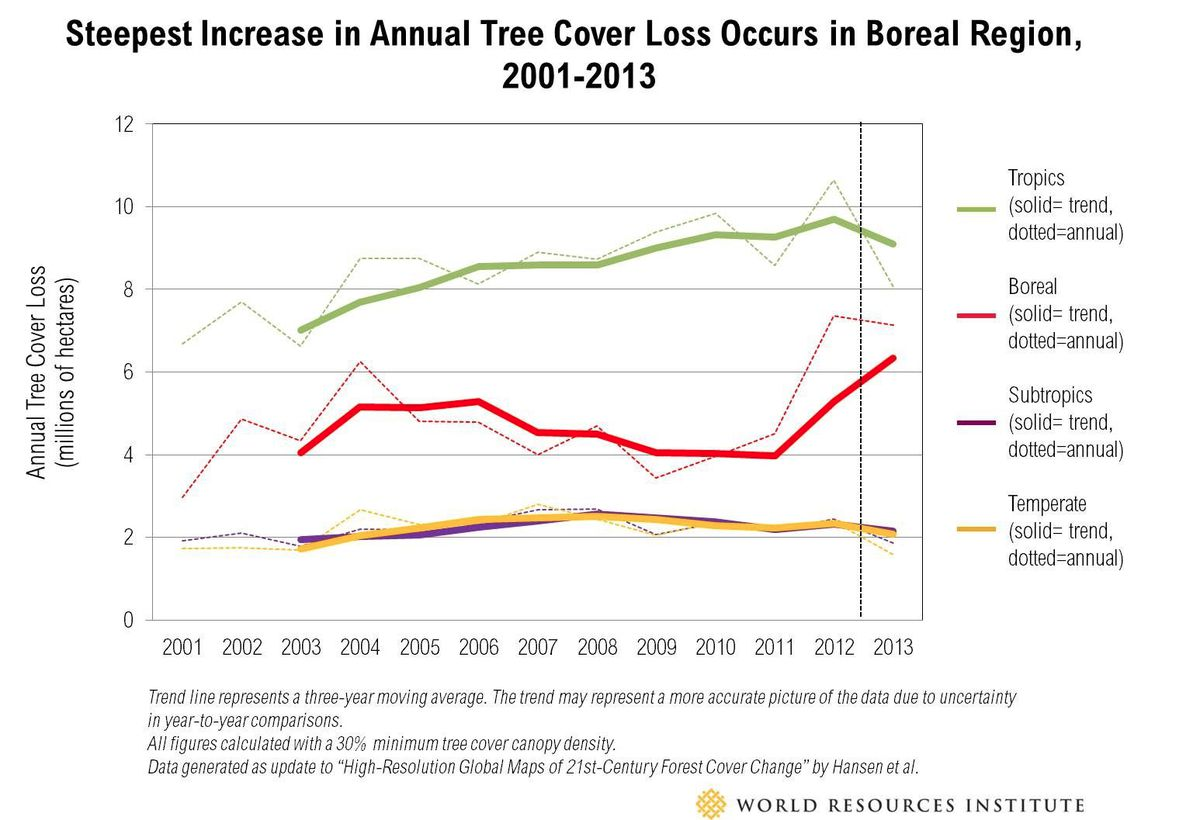Threats to the Taiga
Types of Threat
Deforestation in Borneo’s boreal forest has been rapidly increasing, as shown on the maps above.
The main threat to this biome is the removal of trees, causing destruction of soil/erosion, and habitat destruction.
Biggest Threats
Hydroelectric Development in Canada’s Taiga
Hydroelectric power is generated from the natural flow of water. Hydroelectric developments are found throughout the Canadian taiga forest. Some of the areas particularly influenced are Manitoba, Ontario and Quebec. Canada’s taiga forest has been considerably affected by hydroelectric development to date. More than 625 large dams are currently producing hydropower across Canada, with at least 40% of production coming from rivers originating in or flowing through the taiga forest.
Unfortunately, there are negative aspects to development in the taiga forest. The main consequences are habitat loss and fragmentation. These occur when land is cleared for farmland or flooded to make reservoirs for hydroelectric generating stations.
While the taiga forest harbours few species at risk, some species are being affected by human disturbances. The most well-known species at risk found in the taiga region are some populations of woodland caribou, the wood bison, the Peregrine Falcon, the Yellow Rail, and the Whooping Crane.
Migratory fish, including salmon and others, become blocked from accessing their spawning grounds upriver. And the areas above dams that become flooded with water remove large areas of productive habitat for a wide range of species—from fish and birds to large mammals such as caribou and wolves.
Potential Effects of Oil Sands on Aquatic Ecosystems
Oil sands development consumes large amounts of water and energy—currently, two to five barrels of water (natural sources and recycled water) are required for every barrel of oil produced by mining—and produces contaminated by-products. The industrial processes used, and the large scale of oil sands development, can result in negative impacts on the marine environment if deliberate action is not taken to protect these ecosystems.
Changes to Water and Marine Habitat
Oil sands projects can affect streams, rivers, and lakes through the following activities:
- Site preparation, which can include site clearing, removing or diverting streams, draining wetlands, and altering natural drainage patterns;
- Extraction of groundwater and aquifers
- Removal of water from nearby rivers.
Oil sands mining is currently the largest consumer of water from the Athabasca River basin, with approximately 2% of the average annual water flow in the Athabasca River allocated to oil sands projects.
Changes to Water Quality
The input of these waters can lead to changes in dissolved oxygen levels and changes in stream temperature, both of which can have negative impacts on fish and other marine organisms.
Acidification of Regional Waterbodies
Emissions of sulphur and nitrous oxides from oil sands projects can lead to acidification of lakes. Acidification can have short-term toxic effects on marine animals and vegetation, and can have long-term effects through changes to the marine pH and, ultimately, the health of the ecosystem.
Deforestation
Illegal Logging in the Russian Far East: Global Demand and Taiga Destruction
Twenty years of uncontrolled illegal logging is leading to the exhaustion of a hardwood resource that should have supplied forest industry indefinitely. Ecologists and timber companies agree that large areas of forests have been emptied out of commercial timber for the foreseeable future.
The push by loggers (whether legal or illegal) to open these protective forests is increasing tensions with society, local residents and indigenous peoples who wish to maintain the unique ecological and social value of these forests.
The ever accelerating illegal logging of nut-bearing and pollinating tree species has become a serious threat to the livelihood available in many remote taiga villages. Pine nut harvesting, hunting, sable trapping and forest beekeeping generate essential income for villagers. In contrast to these centuries-old traditions of resource use, rampant illegal logging can lead to the “tapping out” of a region in a few short decades. Left are degraded forests with much fewer resources to support the villagers’ traditional livelihoods. For 15 years, the theft of prime Korean pine timber for short term profit systematically reduced the nut supply in remote villages with sad consequences for people and nature.
Illegal loggers primarily target Korean pine-broadleaf and flood plain forests. Such forests are prime habitats for the Amur tiger, (only 450 left in the wild). But the threats to Far Eastern biodiversity from illegal logging extend far beyond the oak-tiger food chain. Advance of logging into forests threatens endangered bird species such as Blackinston’s fish owl (the world’s largest owl) that nest in the cavities of massive poplar, elm and ash trees.
Differences in Deforestation
- What directly and indirectly threatens the Taiga?
- Your answer should include: Logging / Deforestation / Tar / Sands / Oil
- Explain how logging and fossil fuels are threats to this biome.
- Your answer should include: Climate / Change / Fires / Biodiversity / Local / People
- How has deforestation changed over time in the Taiga?
- Your answer should include: Increased / Rapidly

